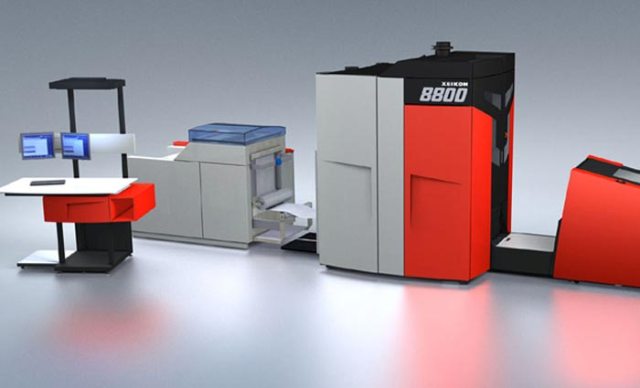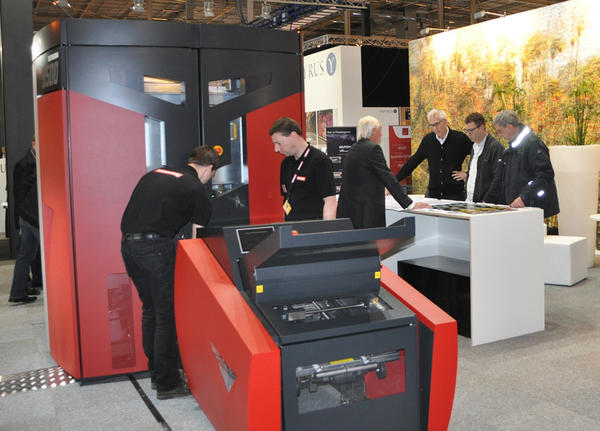
Conventional wisdom has it that Drupa 2012 will be all about inkjet. Tell that to Xeikon, which last month announced a potentially disruptive technology aimed at the high-volume, low-cost digital print market. Like the rest of Xeikon’s presses, the Quantum will be a toner-based device. While the manufacturer is remaining tight-lipped on almost all the details, its headline claim is that the platform will combine the 1,200dpi image quality of its 8000 series LED array-based, electrophotographic printers with the running cost and productivity of high-speed inkjet presses.
Speaking at the firm’s pre-Drupa press conference, chief executive Wim Maes said Quantum had arisen out of a desire for “no compromise”, after Xeikon noticed that for some high-page volume applications, printers were having to trade quality for the greater productivity and lower cost of inkjet.
Rather than OEM an inkjet machine (Maes dismissed this as “the easy option”), Xeikon has apparently come up with a way to solve the fundamental speed limitations of the electrophotographic process, which struggles to maintain resolution at higher speeds due to the fact it uses powder in place of ink.
Ralf Schlözer of Infotrends (see opinion, right) argues that all signs point to the Quantum’s use of a liquid toner technology, similar to HP Indigo’s ElectroInk, as this overcomes some of the speed limitations of dry toner, although it raises its own problems in terms of the time it takes to extract and evaporate the liquid element of the toner.
Interestingly, one of the few things that has been revealed about the Quantum is that it is based on a technology that has been around for some 50 years, which Xeikon acquired through an under-the-radar company purchase some two years ago. While it could be coincidence, this timeframe would fit with the liquid toner argument, as the technology was common in office-based devices back in the 1960s and has enjoyed a renaissance in recent years, particularly with HP Indigo.
Quantum will be aimed at the books, transpromo and direct mail print sectors and Xeikon said it will offer an upgrade programme to allow existing customers to be the first to transition to the new technology, while protecting their initial investments in current platforms.
However, wherever Xeikon pitches the Quantum, there will still be significant obstacles to overcome for it to be adopted on a wide scale. Given what we know of Xeikon’s existing platforms and what has been said so far of the Quantum, the expectation is that it will be a high-speed web press pitched against the likes of the HP T-series and Kodak Prosper platforms. However, this puts it four years behind its competitors and that will likely rise to six before we see a commercial release.
In light of the rapid evolution of inkjet technology, that gives the Quantum a lot of catching up to do. While there is a window for someone to launch a high-speed toner device that addresses the shortcomings of inkjet in terms of quality and the range of substrates it can print on, that window is getting smaller every day.
Kodak has already announced a move to beef up the range of substrates on which its Prosper presses can print with the introduction of a pre-coat unit, while improvements in high-speed inkjet resolutions are sure to continue.
Key advantages
One alternative market might be for existing high-quality sheetfed digital printers to increase the run lengths on which they can compete against either conventional offset or inkjet web presses. However, one of the key advantages to digital print in terms of the ability to print on variable substrates would be negated should the Quantum turn out to be a web press, like Xeikon’s other document presses and rival inkjet devices. With the plethora of B2 digital sheetfed presses set to be on display at Drupa – including inkjet and liquid toner –Xeikon may find that printers prefer the flexibility of sheetfed devices over the speed of web presses for high-quality print applications.
There is also the main issue: cost. In capex terms, digital print is an increasingly expensive business and it is not unusual any more to see digital presses priced on a par with their litho counterparts. With all the focus on technological innovation, this is the one area that is the biggest concern for printers and the most likely to influence purchasing decisions.
Speaking to ProPrint’s UK sister title, PrintWeek, Julian Marsh, photo products consultant at the UK’s largest HP Indigo user, Harrier, had this to say about large-format digital: “As [digital] presses have become more sophisticated and faster, the capital cost has risen, often proportionally. [But] the real advantage to a machine owner is improved click rate and reduced maintenance costs – page price will have to be very enticing to make someone spend £1 million-plus on a B2 Indigo.”
Xeikon has said the Quantum will offer far lower running costs – more akin to inkjet web presses than high-quality toner devices – but if the capital investment turns out to also be commensurate with the HP and Kodak platforms, then that immediately limits the addressable market to medium to large printers. In the UK, the companies in this bracket that can justify that level of spend are already beginning to pin their colours to the mast. Those manufacturers they have allied to will certainly be keen to keep them.
Xeikon has certainly done a good job of building the anticipation around its Quantum launch, which at a show like Drupa, with so many different technologies competing for printers’ attention, is an invaluable asset. Now it just has to deliver.
Factfile
• Xeikon will show a high-speed, toner-based press at Drupa. The Quantum will combine the quality of Xeikon’s 1,200dpi LED array-based kit with the productivity and running cost of inkjet webs
• Quantum will most likely use liquid toner, like HP Indigo’s ElectroInk, as this allows for higher-speed printing than with dry toner, which is difficult to control at high speeds
• Xeikon said Quantum is based on 50-year-old tech via a top secret company purchase around two years ago. This would fit with the advent of liquid toner technology
• It will target books, transpromo and DM, but with many inkjet and toner launches targeting these sectors anticipated at Drupa, including a number of B2 sheetfed devices, Quantum may struggle to penetrate the market
• Cost per page and capital outlay will be key factors in its success
Comment below to have your say on this story.
If you have a news story or tip-off, get in touch at editorial@sprinter.com.au.
Sign up to the Sprinter newsletter



